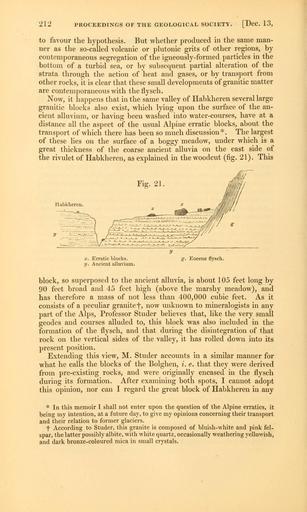MAKE A MEME
View Large Image

| View Original: | The_Quarterly_journal_of_the_Geological_Society_of_London_(12645637094).jpg (1203x2007) | |||
| Download: | Original | Medium | Small | Thumb |
| Courtesy of: | commons.wikimedia.org | More Like This | ||
| Keywords: The Quarterly journal of the Geological Society of London (12645637094).jpg 212 PROCEEDINGS OF THE GEOLOGICAL SOCIETY DcC 13 <br> to favour the hypothesis But whether produced in the same man- <br> ner as the so-called volcanic or plutonic grits of other regions by <br> contemporaneous segregation of the igneously-formed particles in the <br> bottom of a turbid sea or by subsequent partial alteration of the <br> strata through the action of heat and gases or by transport from <br> other rocks it is clear that these small developments of granitic matter <br> are contemporaneous with the flysch <br> Now it happens that in the same valley of Habkheren several large <br> granitic blocks also exist which lying upon the surface of the an- <br> cient alluvium or having been washed into water-courses have at a <br> distance all the aspect of the usual Alpine erratic blocks about the <br> transport of which there has been so much discussion The largest <br> of these lies on the surface of a boggy meadow under which is a <br> great thickness of the coarse ancient alluvia on the east side of <br> the rivulet of Habkheren as explained in the woodcut fig 21 This <br> Habkheren <br> X Erratic blocks <br> 7/ Ancient alluvium <br> g Eocene flysch <br> block so superposed to the ancient alluvia is about 105 feet long by <br> 90 feet broad and 45 feet high above the marshy meadow and <br> has therefore a mass of not less than 400 000 cubic feet As it <br> consists of a peculiar granite f now unknown to mineralogists in any <br> part of the Alps Professor Studer believes that like the very small <br> geodes and courses alluded to this block was also included in the <br> formation of the flysch and that during the disintegration of that <br> rock on the vertical sides of the valley it has rolled down into its <br> present position <br> Extending this view M Studer accounts in a similar manner for <br> what he calls the blocks of the Bolghen i e that they were derived <br> from pre-existing rocks and were originally encased in the flysch <br> during its formation After examining both spots I cannot adopt <br> this opinion nor can I regard the great block of Habkheren in any <br> In this memoir I shall not enter upon the question of the Alpine erratics it <br> being my intention at a future day to give my opinions concerning their transport <br> and their relation to former glaciers <br> t According to Studer this granite is composed of bluish-white and pink fel- <br> spar the latter possibly albite with white quartz occasionally weathering yellowish <br> and dark bronze-coloured mica in small crystals 35268856 109512 51125 Page 212 Text v 5 http //www biodiversitylibrary org/page/35268856 1849 Geological Society of London Biodiversity Heritage Library The Quarterly journal of the Geological Society of London v 5 1849 Geology Periodicals Smithsonian Libraries bhl page 35268856 dc identifier http //biodiversitylibrary org/page/35268856 smithsonian libraries Information field Flickr posted date ISOdate 2014-02-20 Check categories 2015 August 26 CC-BY-2 0 BioDivLibrary https //flickr com/photos/61021753 N02/12645637094 2015-08-27 10 53 04 cc-by-2 0 PD-old-70-1923 The Quarterly journal of the Geological Society of London 1849 Photos uploaded from Flickr by Fæ using a script | ||||